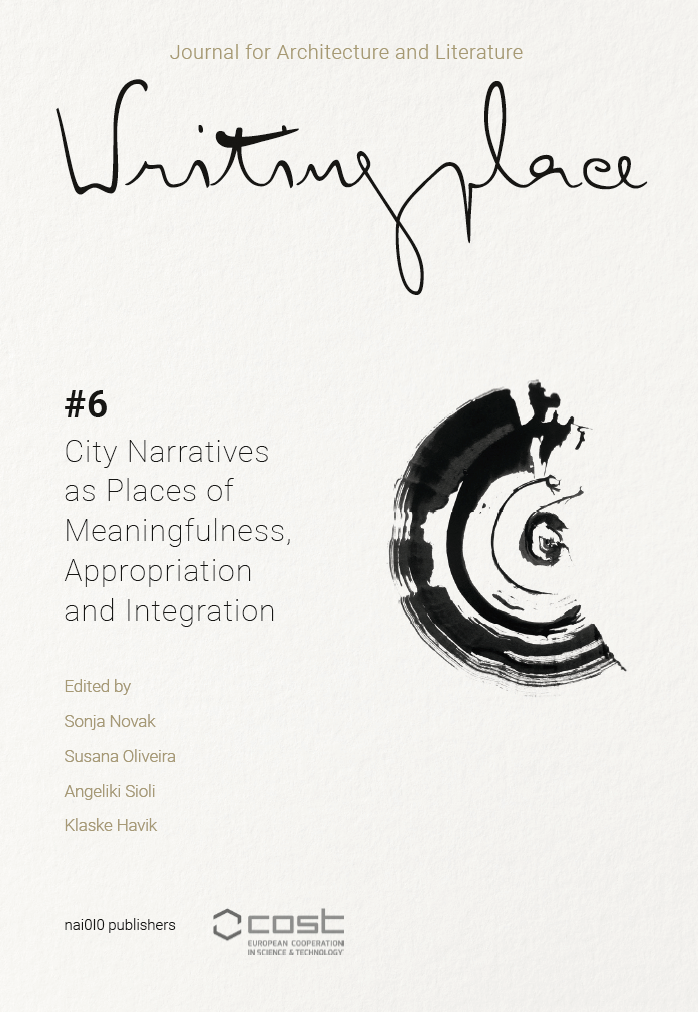Sites of Narrativity and Spatial Debate
Fences in Neighbourhoods in the Port of Riga
DOI:
https://doi.org/10.7480/writingplace.6.6360Abstract
Based on an ethnographic study of the neighbourhoods in the vicinity of the Port of Riga, the article examines people’s engagement with fences surrounding the territory of the port. It reacts to an observation that walls, fences and their materiality are underrepresented in research. Focusing on human engagement with the narrativity of the physical world, the article treats port’s fences as ‘storied matter’. This includes, first, an observation that these built structures constitute a narrative subject matter frequently appearing in the interviews of the lower Daugava residents. In addition, the discursivity of the Port of Riga’s fences is contemplated as constituted by their function, enforced or disputed by spatial forms of discourse (signposts, warnings, graffiti) and shaped via symbolic activities of the involved parties, which both address place-appropriation issues and transform the communicative character of these spatial objects.
References
Joachim Otto Habeck and Galina Belolyubskaya, ‘Fences, Private and Public Spaces, and Traversability in a Siberian City’, Cities 56 (2016), 119.
‘Living Next to the Port: Eco-Narratives, Local Histories, and Environmental Activism in the Daugava Delta’ (lzp - 2018/1-0446), funded by the Latvian Council of Science and implemented at the Institute of Literature, Folklore and Art, University of Latvia, 2018-2021. The oral narratives that constitute the empirical material of the article come from qualitative interviews with the residents (92 in total) of the four studied neighbourhoods.
Serenella Iovino and Serpil Oppermann (eds.), Material Ecocriticism (Bloomington/Indianapolis, 2014), 1.
Charles Landry, The Creative City: A Toolkit for Urban Innovators (London, 2000), 246.
Klaske Havik, Urban Literacy: Reading and Writing Architecture (Rotterdam, 2014).
Umberto Eco, ‘Function and Sign: The Semiotics of Architecture’, in: Neil Leach (ed.), Rethinking Architecture: A Reader in Cultural Theory (London/New York, 1997), 182.
Crystal Victoria Filep, Michelle Thompson-Fawcett and Murray Rae, ‘Built Narratives’, Journal of Urban Design 19 (2014), 310.
Tim Ingold, The Perception of Environment (London/New York, 2000), 189.
Mark Turner, The Literary Mind (Oxford, 1996), 47.
Marie-Laure Ryan, ‘Toward a Definition of Narrative’, in: David Herman (ed.), The Cambridge Companion to Narrative (Cambridge, 2007), 28.
Marie-Laure Ryan, Kenneth Foote and Maoz Azaryahu, Narrating Space/Spatializing Narrative: Where Narrative Theory and Geography Meet (Ohio, 2016), 139.
Timothy Clark, The Value of Ecocriticism (Cambridge, 2019), 124-136.
Karen Barad, Meeting the Universe Halfway: Quantum Physics and the Entanglement of Matter and Meaning (Durham, NC/London, 2007), 151.
See: Jean Clandinin and Michael Connelly, Narrative Inquiry: Experience and Story in Qualitative Research (San Francisco, 2000).
The Free Port of Riga Law, adopted 3rd March 2000, envisages that the rented sectors of all companies within the port’s territory be securely enclosed and guarded, see: likumi.lv/ta/en/en/id/3435.
Alfredo Mela, ‘Urban Public Space between Fragmentation, Control and Conflict’, City, Territory and Architecture 1 (2014), 1-15.
Rīgas ilgstpējīgas attīstības stratēģija līdz 2030. gadam (Riga, 2014), 67.
Serenella Iovino and Serpil Oppermann, ‘Material Ecocriticism: Materiality, Agency, and Models of Narrativity’, Ecozon@ 3 (2012), 81.
Paul Cloke and Owain Jones, ‘Dwelling, Place, and Landscape: An Orchard in Somerset’, Environment and Planning A 33 (2001), 664.
Nima Talebian and Turkan Ulusu Uraz, ‘The Post-Phenomenology of Place: Moving Forward from Phenomenological to Post-Structural Readings of Place’, Open House International 43 (2018), 15.
Georg Simmel, ‘Bridge and Door’, in: Leach, Rethinking Architecture, op cit. (note 6), 66-69.
Evan Hennessy Carver, ‘Graffiti Writing as Urban Narrative’, Literary Geographies 4 (2018), 188.
Downloads
Published
How to Cite
Issue
Section
License
Copyright (c) 2022 Dace Bula

This work is licensed under a Creative Commons Attribution 4.0 International License.



